By Ben Grunwald, John Rappaport and Michael Berg
Private security officers outnumber police by a wide margin, and the gap may be growing. As cities have claimed to defund the police, many have quietly expanded their use of private security, reallocating spending from the public to the private sector. It is difficult to know what to make of these trends, largely because we know so little about what private security looks like on the ground. On one prevalent view of the facts, a shift from public to private security would mean little more than a change of uniform, as the two labor markets are deeply intertwined. Indeed, academics, the media, popular culture, and the police themselves all tell us that private security is some amalgam of a police retirement community and a dumping ground for disgraced former cops. But if, instead, private officers differ systematically from the public police—and crossover between the sectors is limited—then substitution from policing to private security could drastically change who is providing security services.
We bring novel data to bear on these questions, presenting the largest empirical study of private security to date. We introduce an administrative dataset covering nearly 300,000 licensed private security officers in the State of Florida. By linking this dataset to similarly comprehensive information about public law enforcement, we have, for the first time, a nearly complete picture of the entire security labor market in one state. We report two principal findings. First, the public and private security markets are predominantly characterized by occupational segregation, not integration. The individuals who compose the private security sector differ markedly from the public police; they are, for example, significantly less likely to be white men. We also find that few private officers, roughly 2%, have previously worked in public policing, and even fewer will go on to policing in the future. Second, while former police make up a small share of all private security, roughly a quarter of cops who do cross over have been fired from a policing job. In fact, fired police officers are nearly as likely to land in private security as to find another policing job, and a full quarter end up in one or the other. We explore the implications of these findings, including intersections with police abolition and the future of policing, at the paper’s close.
Journal of Empirical Legal Studies, Forthcoming . U of Chicago, Public Law Working Paper No. 850. University of Chicago Coase-Sandor Institute for Law & Economics Research Paper No. 1004. Duke Law School Public Law & Legal Theory Series No. 2024-24













